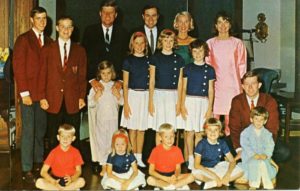A Tutorial from NHS Genealogist Bert Lippincott

Nine generations of the Scott family, circa 1608: “The pedigree of the most auntient (sic) And knightly family of the Scotts of Scottshall in the County of Kent with the several matches, issue and transplants of whome is descended Edward Scott of Glemsford in the county of Suffolke.”, 79.2.4, NHS Collection
People who are familiar with genealogical research have found that families are big and complicated, so you need to pick and choose which branches to concentrate on. You can never finish; the numbers are just too big.
Each generation you follow doubles in the preceding generation: two parents, four grandparents, eight great grandparents, sixteen great, great grandparents, and so on. If you carry this further, mathematically, you will have more ancestors than the population of North America. Go back farther and you will have more ancestors than the population of Europe. To make the population of your family tree more manageable, cousin marriages can cut the numbers in half, whether it be first cousin marriages (quite naughty or illegal in most places) or 10th cousin marriages (Do you even know your 10th cousins? You may have married one!)
Starting your research from the past is tricky, the procreation of early settler families can produce staggering numbers. This year marks the 400th anniversary of the landing of the Mayflower at Plymouth in 1620. The Mayflower only carried 102 passengers. Those people produced an estimated 30 million descendants over, say, 15 generations according to The Society of Mayflower Descendants and the New England Historical Genealogical Society.

Each generation you follow doubles in the preceding generation: The Alexander R. Walsh Family pictured at Hammersmith Farm, with President John F. Kennedy, Caroline Kennedy, Jacqueline Kennedy, and John F. Kennedy, Jr., 64.5, NHS Collection
In Rhode Island, early families are well documented. A colonial settler of Newport, Frances (Latham) Dungan Clarke Vaughan (d. 1677) produced 82 great grandchildren. Some other settlers, Roger Williams for example, produced similar numbers. A great resource for tracking these early families is The Genealogical Dictionary of Rhode Island by John O. Austin. (1877 with reprints, corrections and additions). This work studies the first three to four generations of over 200 early families. See if any of your ancestral surnames are in the index.
Where did all of these people go? At some point families outgrow their homestead dwellings, and maybe they outgrew their jobs and relatives – so they moved. There were several important colonization and missionary efforts initiated by Rhode Island families which helped spread them beyond the borders of Rhode Island.
Monmouth County, New Jersey was settled by Rhode Island Baptists and Quakers in the 1660s in an attempt to help plant English Protestants in an area lost by Peter Stuyvesant and the Dutch.
Business and Quaker interests attracted Rhode Island settlers to Flushing, Oyster Bay and Pelham Bay. Hutchinson, Willett, Sands, Cornell and Throckmorton (corrupted to “Throgs”) were all Rhode Island families.
Dartmouth, Massachusetts, a halfway meeting place of Rhode Island Quakers and Cape Cod Pilgrims in an area contested by the Plymouth and Massachusetts Bay colonies.
Upstate New York, starting in the 1720s filled with Baptists and Seventh Day Baptists from Westerly, Rhode Island. They largely settled in areas around Alfred, Berlin and Hoosick. Cemeteries in those places are loaded with Rhode Island Hubbard’s, Burdicks and Crandalls, and Seventh Day Baptist congregations continue to thrive there today.
Thousands of descendants versus thousands of ancestors will cross-over many, many times. The Newport Historical Society has the latest and most accurate information on Southeastern New England towns and families and particular studies of the aforementioned migration regions. Your ancestors are out there, waiting to be found!